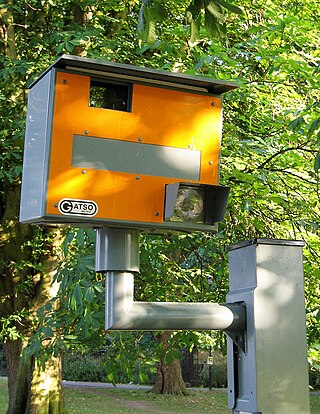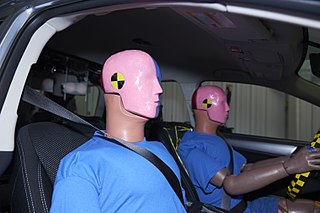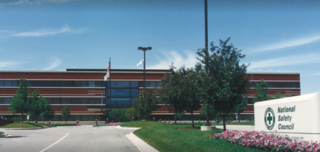
A traffic enforcement camera is a camera which may be mounted beside or over a road or installed in an enforcement vehicle to detect motoring offenses, including speeding, vehicles going through a red traffic light, vehicles going through a toll booth without paying, unauthorized use of a bus lane, or for recording vehicles inside a congestion charge area. It may be linked to an automated ticketing system.

A crash test dummy, or simply dummy, is a full-scale anthropomorphic test device (ATD) that simulates the dimensions, weight proportions and articulation of the human body during a traffic collision. Dummies are used by researchers, automobile and aircraft manufacturers to predict the injuries a person might sustain in a crash. Modern dummies are usually instrumented to record data such as velocity of impact, crushing force, bending, folding, or torque of the body, and deceleration rates during a collision.

The University of Alabama in Huntsville (UAH) is a public research university in Huntsville, Alabama. The university is accredited by the Southern Association of Colleges and Schools and comprises nine colleges: arts, humanities & social sciences; business; education; engineering; honors; nursing; professional & continuing studies; science; and graduate. The university's enrollment is approximately 10,000. It is part of the University of Alabama System and is classified among "R1: Doctoral Universities: Very High Research Activity".

An advanced driver-assistance system (ADAS) is any of a groups of electronic technologies that assist drivers in driving and parking functions. Through a safe human-machine interface, ADAS increase car and road safety. ADAS uses automated technology, such as sensors and cameras, to detect nearby obstacles or driver errors, and respond accordingly. ADAS can enable various levels of autonomous driving, depending on the features installed in the car.
The Research and Innovative Technology Administration (RITA) is a unit of the United States Department of Transportation (USDOT). It was created in 2005 to advance transportation science, technology, and analysis, as well as improve the coordination of transportation research within the department and throughout the transportation community.

The National Safety Council (NSC) is a 501(c)(3) nonprofit, public service organization promoting health and safety in the United States. Headquartered in Itasca, Illinois, NSC is a member organization, founded in 1913 and granted a congressional charter in 1953. Members include more than 55,000 businesses, labor organizations, schools, public agencies, private groups and individuals.

The National Weather Center (NWC), on the campus of the University of Oklahoma, is a confederation of federal, state, and academic organizations that work together to better understand events that take place in Earth's atmosphere over a wide range of time and space scales. The NWC partners give equal attention to applying that understanding to the development of improved observation, analysis, assimilation, display, and prediction systems. The National Weather Center also has expertise in local and regional climate, numerical modeling, hydrology, and weather radar. Members of the NWC work with a wide range of federal, state, and local government agencies to help reduce loss of life and property to hazardous weather, ensure wise use of water resources, and enhance agricultural production. They also work with private sector partners to develop new applications of weather and regional climate information that provide competitive advantage in the marketplace.

The Ohio State Highway Patrol is a division of the Ohio Department of Public Safety and has the primary responsibility of traffic enforcement in the state of Ohio.

The Hurt Report, officially Motorcycle Accident Cause Factors and Identification of Countermeasures, was a motorcycle safety study conducted in the United States, initiated in 1976 and published in 1981. The report is named after its primary author, Professor Harry Hurt.
Advanced Automatic Collision Notification (AACN) is the successor to Automatic Collision Notification (ACN). To develop procedures that will help emergency medical responders better and more quickly determine if a motorist needs care at a trauma center after a vehicle crash, Center for Disease Control and the CDC Foundation recently partnered with OnStar and the GM Foundation. Through this partnership, CDC conducted a vehicle telematics initiative to develop evidence-based protocols for the emergency medical community to effectively use automotive telemetry data.

A collision avoidance system (CAS), also known as a pre-crash system, forward collision warning system (FCW), or collision mitigation system, is an advanced driver-assistance system designed to prevent or reduce the severity of a collision. In its basic form, a forward collision warning system monitors a vehicle's speed, the speed of the vehicle in front of it, and the distance between the vehicles, so that it can provide a warning to the driver if the vehicles get too close, potentially helping to avoid a crash. Various technologies and sensors that are used include radar (all-weather) and sometimes laser (LIDAR) and cameras to detect an imminent crash. GPS sensors can detect fixed dangers such as approaching stop signs through a location database. Pedestrian detection can also be a feature of these types of systems.

A traffic collision, also called a motor vehicle collision, occurs when a vehicle collides with another vehicle, pedestrian, animal, road debris, or other moving or stationary obstruction, such as a tree, pole or building. Traffic collisions often result in injury, disability, death, and property damage as well as financial costs to both society and the individuals involved. Road transport is the most dangerous situation people deal with on a daily basis, but casualty figures from such incidents attract less media attention than other, less frequent types of tragedy. The commonly used term car accident is increasingly falling out of favor with many government departments and organizations, with the Associated Press style guide recommending caution before using the term.

Massi Joe E. Kiani is an Iranian-American entrepreneur who founded medical technology company Masimo in 1989.

INRIX is a private company headquartered in Kirkland, Washington, US. It provides location-based data and software-as-a-service analytics — such as real-time and historical traffic conditions, road safety, and parking availability — to automakers, businesses, cities, and road authorities worldwide, as well as turn-by-turn navigation applications such as Google Waze. INRIX also publishes research reports on traffic congestion, parking, roadway safety, retail site selection, and autonomous vehicles in major cities.
The Utah Science Technology and Research Initiative (USTAR) is a technology-based economic development agency funded by the state of Utah. The organization works to develop ideas and research into marketable products and successful companies through its competitive grant and entrepreneur support programs. USTAR facilitates the diversification of the state’s tech economy, increases private follow-on investment, and supports the creation of technology-based start-up firms, higher-paying jobs and additional business activity leading to a statewide expansion of Utah’s tax base.

George Washington University Virginia Graduate Campus is the campus of George Washington University in the Ashburn area of unincorporated Loudoun County, Virginia, United States.
Fatigue detection software is intended to reduce fatigue related fatalities and incidents. Several companies are working on a technology for use in industries such as mining, road- and rail haulage and aviation. The technology may soon find wider applications in industries such as health care and education.

SaveLIFE Foundation (SLF) is an independent, non-profit, non-governmental organization focused on improving road safety and emergency medical care across India. SLF combines evidence-based research with policy advocacy, communication, and on-ground execution of projects in the two areas of crash prevention as well as post-crash response. Over the past few years, SLF has facilitated the enactment of the Good Samaritan Law in India, which insulates lay rescuers of injured victims from ensuing legal and procedural hassles. It has also adopted the Mumbai Pune Expressway to transform it into a Zero Fatality Corridor, trained several thousand Police personnel and citizens in basic life-saving techniques, and built technology platforms to assist road users and those interested in road safety.

Iteris Inc. is an American company based in Santa Ana, California that provides software, hardware and services for smart mobility infrastructure management, including software as a service, cloud-enabled managed services, consulting and advisory services, and sensors and other devices that record and predict traffic conditions. Iteris Inc. was established in 2004. The company from which it was formed, Odetics Inc., was originally founded in 1969, in Anaheim, California and incorporated in Delaware in 1987. Joe Bergera has served as the company's president and chief executive officer since 2015, and Iteris reported revenue of $117.1 million in fiscal year 2021, ending March 31.
FeGiS is a road traffic safety research project for the early identification of danger points in road traffic and for the prevention of traffic accidents in Germany. The project was launched in December 2017 and was funded by the "mFund" of the Federal Ministry for Digital and Transport in two second funding stages, thanks to the successful completion of the FeGiS feasibility study in 2018.
















